Supplier Integration Strategy for Deere's Skid-Steer Loader Design
VerifiedAdded on 2021/06/18
|13
|2853
|189
Report
AI Summary
This report, prepared for Deere Company, focuses on the critical aspects of supplier integration for the design and development of skid-steer loaders. It begins by outlining the steps, tools, and techniques for supplier selection, including defining business needs, determining specifications, establishing measurement criteria, identifying buying alternatives, and conducting the actual supplier selection process. The report details various selection techniques, such as prequalification methods (cluster analysis, data envelopment analysis, categorical methods), mathematical programming techniques, multi-attribute decision-making techniques (analytical hierarchal process, analytical network process, total cost ownership model, and outranking methods), and artificial intelligence methods. Furthermore, it addresses the challenges associated with supplier integration, such as difficulties in defining business needs, quantifying assessment criteria, evaluating suppliers, and effective information sharing. The report suggests ways to mitigate these challenges, including fostering strong employment relationships, employing strategic communication plans, investing in research, and utilizing technology systems. Finally, it highlights the benefits of implementing the proposed procedure, such as improved information flow, cost savings, reduced logistics issues, and enhanced service quality, concluding with a comprehensive supplier evaluation and selection form.
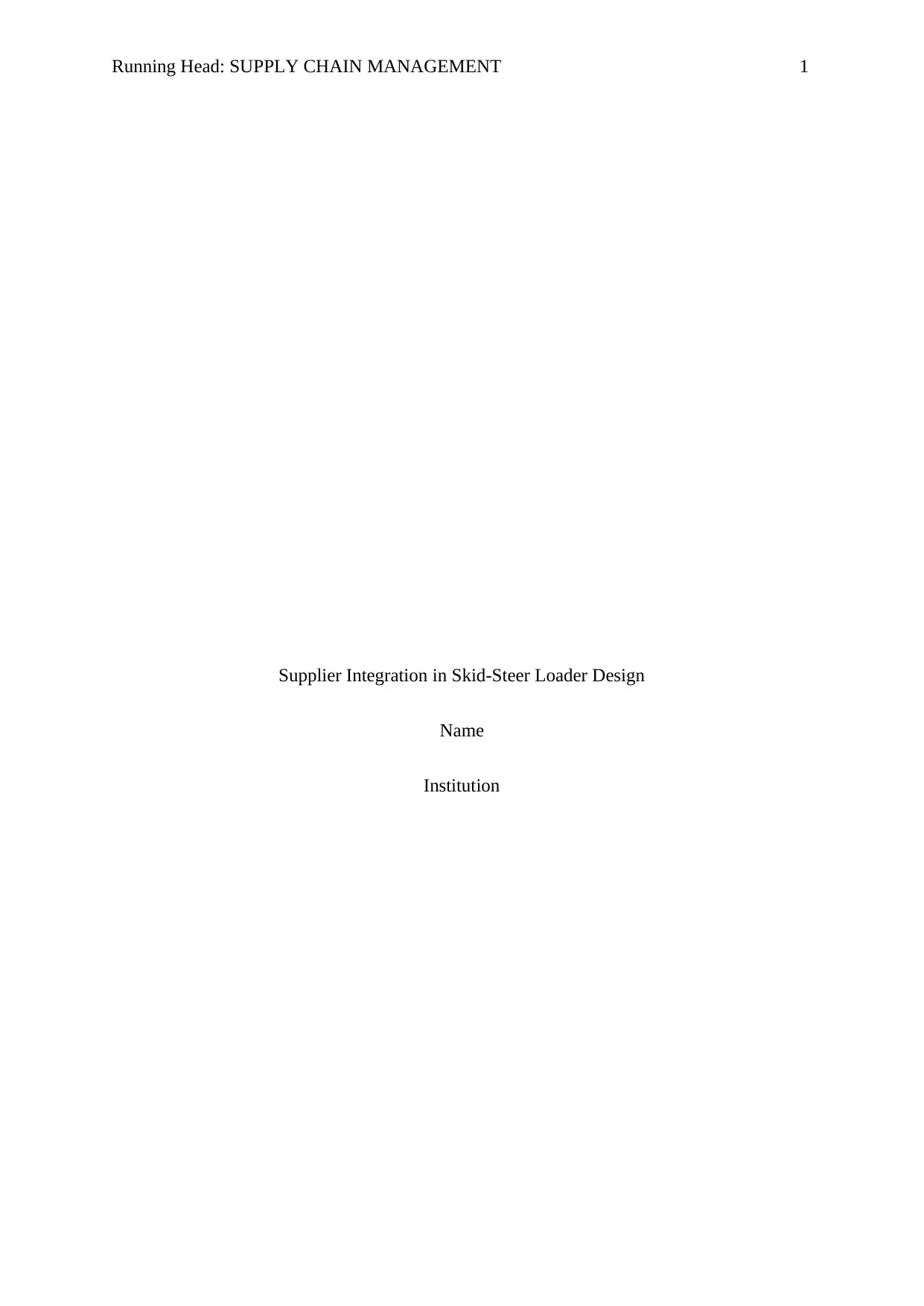
Running Head: SUPPLY CHAIN MANAGEMENT 1
Supplier Integration in Skid-Steer Loader Design
Name
Institution
Supplier Integration in Skid-Steer Loader Design
Name
Institution
Paraphrase This Document
Need a fresh take? Get an instant paraphrase of this document with our AI Paraphraser
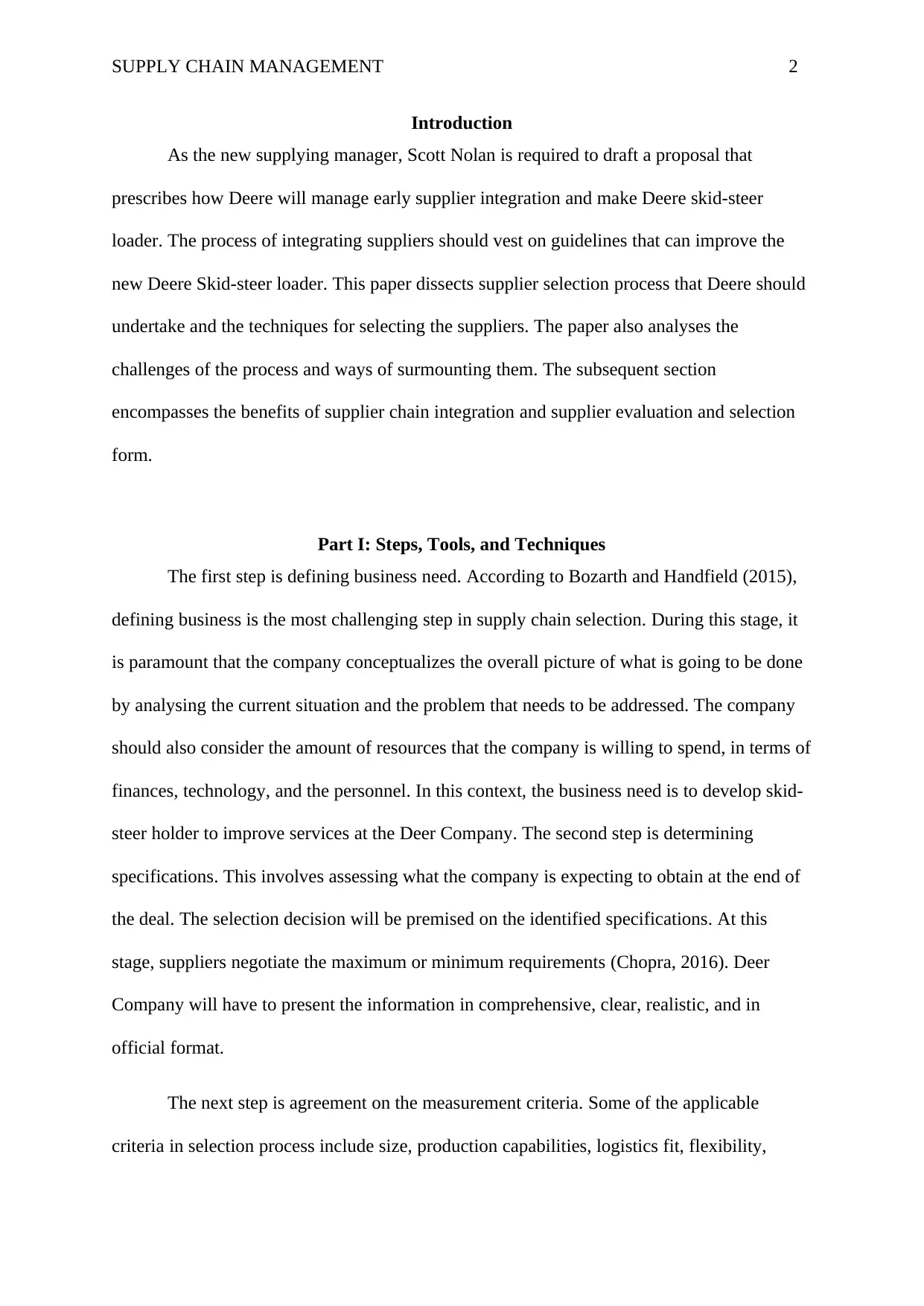
SUPPLY CHAIN MANAGEMENT 2
Introduction
As the new supplying manager, Scott Nolan is required to draft a proposal that
prescribes how Deere will manage early supplier integration and make Deere skid-steer
loader. The process of integrating suppliers should vest on guidelines that can improve the
new Deere Skid-steer loader. This paper dissects supplier selection process that Deere should
undertake and the techniques for selecting the suppliers. The paper also analyses the
challenges of the process and ways of surmounting them. The subsequent section
encompasses the benefits of supplier chain integration and supplier evaluation and selection
form.
Part I: Steps, Tools, and Techniques
The first step is defining business need. According to Bozarth and Handfield (2015),
defining business is the most challenging step in supply chain selection. During this stage, it
is paramount that the company conceptualizes the overall picture of what is going to be done
by analysing the current situation and the problem that needs to be addressed. The company
should also consider the amount of resources that the company is willing to spend, in terms of
finances, technology, and the personnel. In this context, the business need is to develop skid-
steer holder to improve services at the Deer Company. The second step is determining
specifications. This involves assessing what the company is expecting to obtain at the end of
the deal. The selection decision will be premised on the identified specifications. At this
stage, suppliers negotiate the maximum or minimum requirements (Chopra, 2016). Deer
Company will have to present the information in comprehensive, clear, realistic, and in
official format.
The next step is agreement on the measurement criteria. Some of the applicable
criteria in selection process include size, production capabilities, logistics fit, flexibility,
Introduction
As the new supplying manager, Scott Nolan is required to draft a proposal that
prescribes how Deere will manage early supplier integration and make Deere skid-steer
loader. The process of integrating suppliers should vest on guidelines that can improve the
new Deere Skid-steer loader. This paper dissects supplier selection process that Deere should
undertake and the techniques for selecting the suppliers. The paper also analyses the
challenges of the process and ways of surmounting them. The subsequent section
encompasses the benefits of supplier chain integration and supplier evaluation and selection
form.
Part I: Steps, Tools, and Techniques
The first step is defining business need. According to Bozarth and Handfield (2015),
defining business is the most challenging step in supply chain selection. During this stage, it
is paramount that the company conceptualizes the overall picture of what is going to be done
by analysing the current situation and the problem that needs to be addressed. The company
should also consider the amount of resources that the company is willing to spend, in terms of
finances, technology, and the personnel. In this context, the business need is to develop skid-
steer holder to improve services at the Deer Company. The second step is determining
specifications. This involves assessing what the company is expecting to obtain at the end of
the deal. The selection decision will be premised on the identified specifications. At this
stage, suppliers negotiate the maximum or minimum requirements (Chopra, 2016). Deer
Company will have to present the information in comprehensive, clear, realistic, and in
official format.
The next step is agreement on the measurement criteria. Some of the applicable
criteria in selection process include size, production capabilities, logistics fit, flexibility,
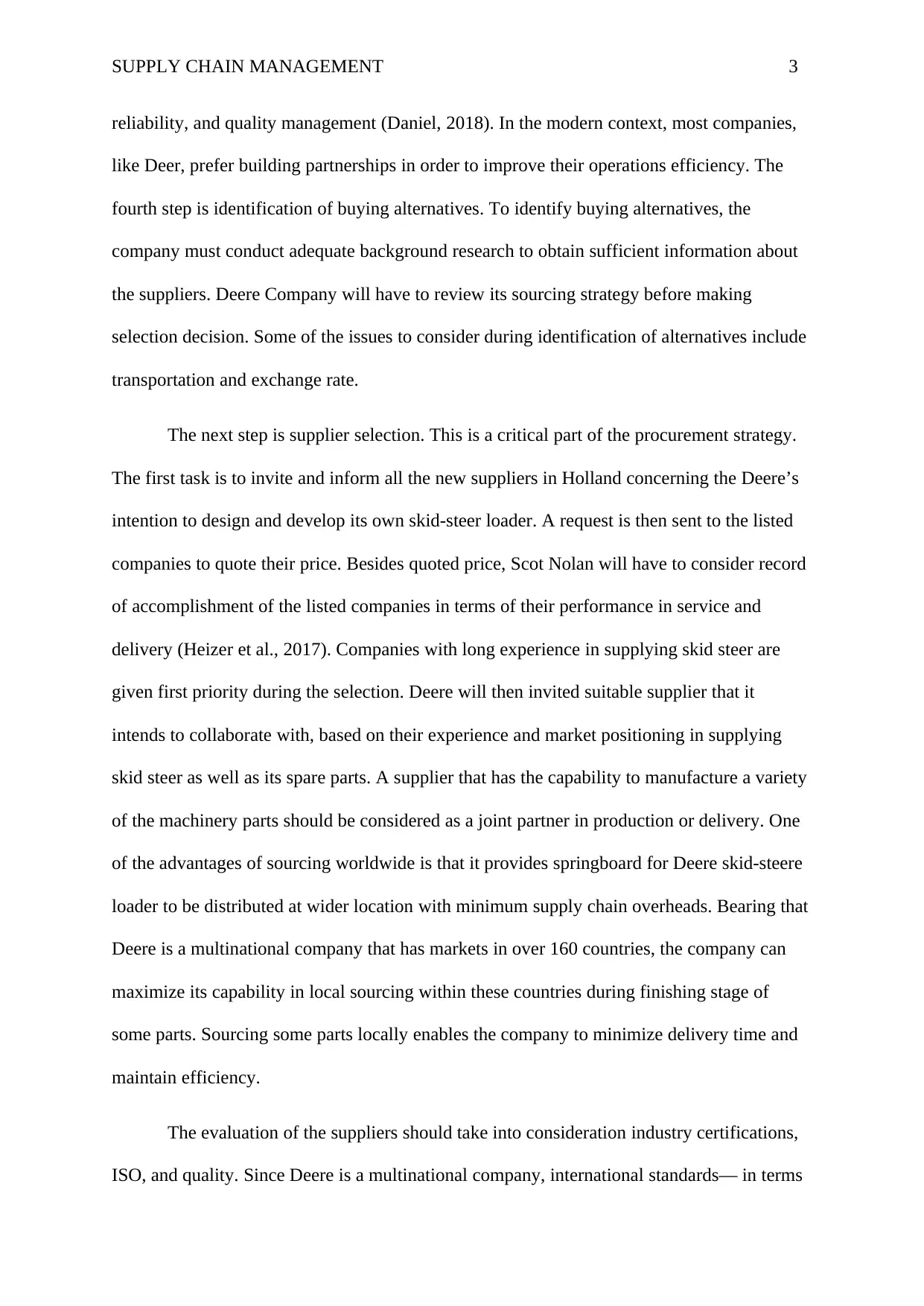
SUPPLY CHAIN MANAGEMENT 3
reliability, and quality management (Daniel, 2018). In the modern context, most companies,
like Deer, prefer building partnerships in order to improve their operations efficiency. The
fourth step is identification of buying alternatives. To identify buying alternatives, the
company must conduct adequate background research to obtain sufficient information about
the suppliers. Deere Company will have to review its sourcing strategy before making
selection decision. Some of the issues to consider during identification of alternatives include
transportation and exchange rate.
The next step is supplier selection. This is a critical part of the procurement strategy.
The first task is to invite and inform all the new suppliers in Holland concerning the Deere’s
intention to design and develop its own skid-steer loader. A request is then sent to the listed
companies to quote their price. Besides quoted price, Scot Nolan will have to consider record
of accomplishment of the listed companies in terms of their performance in service and
delivery (Heizer et al., 2017). Companies with long experience in supplying skid steer are
given first priority during the selection. Deere will then invited suitable supplier that it
intends to collaborate with, based on their experience and market positioning in supplying
skid steer as well as its spare parts. A supplier that has the capability to manufacture a variety
of the machinery parts should be considered as a joint partner in production or delivery. One
of the advantages of sourcing worldwide is that it provides springboard for Deere skid-steere
loader to be distributed at wider location with minimum supply chain overheads. Bearing that
Deere is a multinational company that has markets in over 160 countries, the company can
maximize its capability in local sourcing within these countries during finishing stage of
some parts. Sourcing some parts locally enables the company to minimize delivery time and
maintain efficiency.
The evaluation of the suppliers should take into consideration industry certifications,
ISO, and quality. Since Deere is a multinational company, international standards— in terms
reliability, and quality management (Daniel, 2018). In the modern context, most companies,
like Deer, prefer building partnerships in order to improve their operations efficiency. The
fourth step is identification of buying alternatives. To identify buying alternatives, the
company must conduct adequate background research to obtain sufficient information about
the suppliers. Deere Company will have to review its sourcing strategy before making
selection decision. Some of the issues to consider during identification of alternatives include
transportation and exchange rate.
The next step is supplier selection. This is a critical part of the procurement strategy.
The first task is to invite and inform all the new suppliers in Holland concerning the Deere’s
intention to design and develop its own skid-steer loader. A request is then sent to the listed
companies to quote their price. Besides quoted price, Scot Nolan will have to consider record
of accomplishment of the listed companies in terms of their performance in service and
delivery (Heizer et al., 2017). Companies with long experience in supplying skid steer are
given first priority during the selection. Deere will then invited suitable supplier that it
intends to collaborate with, based on their experience and market positioning in supplying
skid steer as well as its spare parts. A supplier that has the capability to manufacture a variety
of the machinery parts should be considered as a joint partner in production or delivery. One
of the advantages of sourcing worldwide is that it provides springboard for Deere skid-steere
loader to be distributed at wider location with minimum supply chain overheads. Bearing that
Deere is a multinational company that has markets in over 160 countries, the company can
maximize its capability in local sourcing within these countries during finishing stage of
some parts. Sourcing some parts locally enables the company to minimize delivery time and
maintain efficiency.
The evaluation of the suppliers should take into consideration industry certifications,
ISO, and quality. Since Deere is a multinational company, international standards— in terms
⊘ This is a preview!⊘
Do you want full access?
Subscribe today to unlock all pages.

Trusted by 1+ million students worldwide
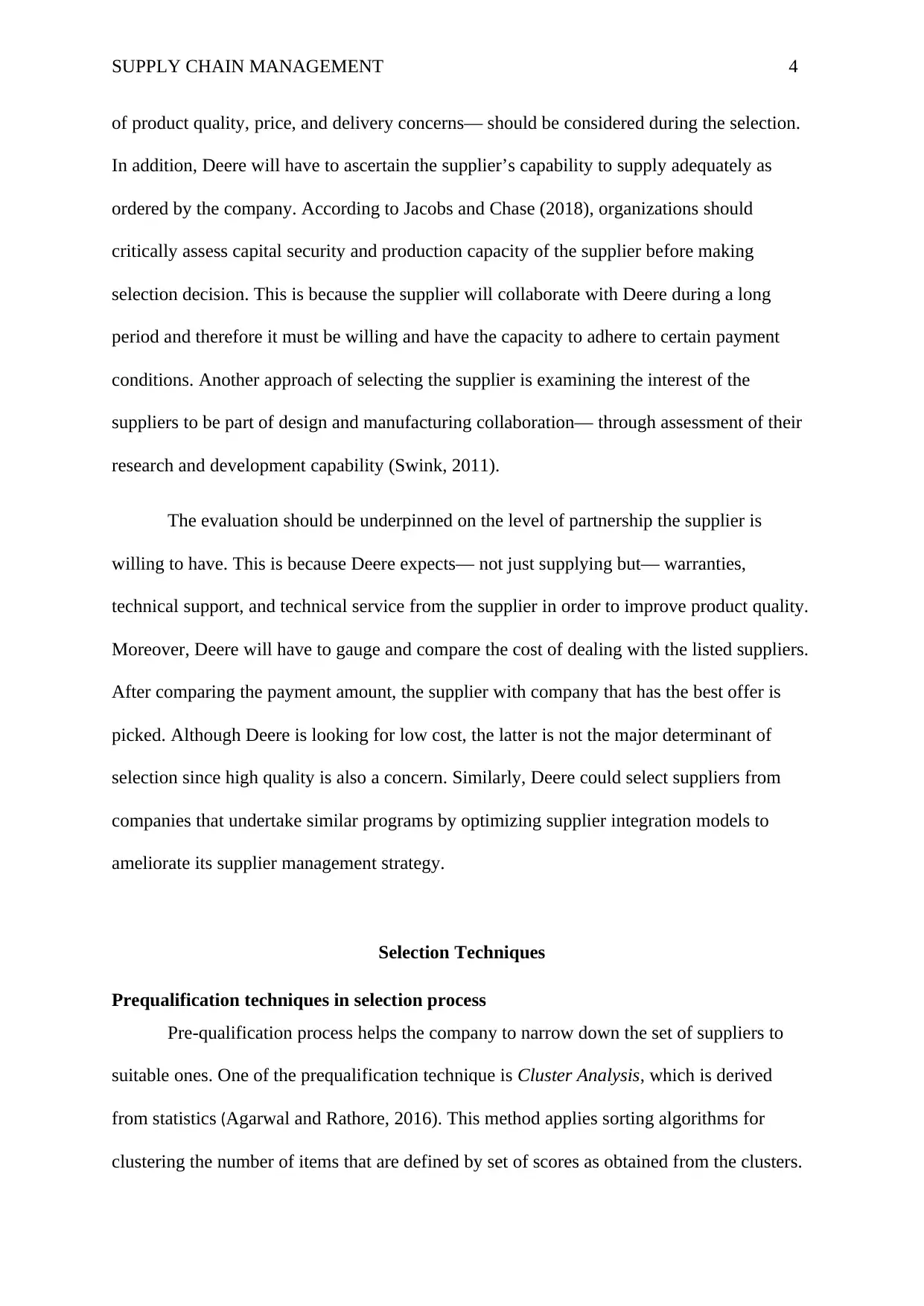
SUPPLY CHAIN MANAGEMENT 4
of product quality, price, and delivery concerns— should be considered during the selection.
In addition, Deere will have to ascertain the supplier’s capability to supply adequately as
ordered by the company. According to Jacobs and Chase (2018), organizations should
critically assess capital security and production capacity of the supplier before making
selection decision. This is because the supplier will collaborate with Deere during a long
period and therefore it must be willing and have the capacity to adhere to certain payment
conditions. Another approach of selecting the supplier is examining the interest of the
suppliers to be part of design and manufacturing collaboration— through assessment of their
research and development capability (Swink, 2011).
The evaluation should be underpinned on the level of partnership the supplier is
willing to have. This is because Deere expects— not just supplying but— warranties,
technical support, and technical service from the supplier in order to improve product quality.
Moreover, Deere will have to gauge and compare the cost of dealing with the listed suppliers.
After comparing the payment amount, the supplier with company that has the best offer is
picked. Although Deere is looking for low cost, the latter is not the major determinant of
selection since high quality is also a concern. Similarly, Deere could select suppliers from
companies that undertake similar programs by optimizing supplier integration models to
ameliorate its supplier management strategy.
Selection Techniques
Prequalification techniques in selection process
Pre-qualification process helps the company to narrow down the set of suppliers to
suitable ones. One of the prequalification technique is Cluster Analysis, which is derived
from statistics (Agarwal and Rathore, 2016). This method applies sorting algorithms for
clustering the number of items that are defined by set of scores as obtained from the clusters.
of product quality, price, and delivery concerns— should be considered during the selection.
In addition, Deere will have to ascertain the supplier’s capability to supply adequately as
ordered by the company. According to Jacobs and Chase (2018), organizations should
critically assess capital security and production capacity of the supplier before making
selection decision. This is because the supplier will collaborate with Deere during a long
period and therefore it must be willing and have the capacity to adhere to certain payment
conditions. Another approach of selecting the supplier is examining the interest of the
suppliers to be part of design and manufacturing collaboration— through assessment of their
research and development capability (Swink, 2011).
The evaluation should be underpinned on the level of partnership the supplier is
willing to have. This is because Deere expects— not just supplying but— warranties,
technical support, and technical service from the supplier in order to improve product quality.
Moreover, Deere will have to gauge and compare the cost of dealing with the listed suppliers.
After comparing the payment amount, the supplier with company that has the best offer is
picked. Although Deere is looking for low cost, the latter is not the major determinant of
selection since high quality is also a concern. Similarly, Deere could select suppliers from
companies that undertake similar programs by optimizing supplier integration models to
ameliorate its supplier management strategy.
Selection Techniques
Prequalification techniques in selection process
Pre-qualification process helps the company to narrow down the set of suppliers to
suitable ones. One of the prequalification technique is Cluster Analysis, which is derived
from statistics (Agarwal and Rathore, 2016). This method applies sorting algorithms for
clustering the number of items that are defined by set of scores as obtained from the clusters.
Paraphrase This Document
Need a fresh take? Get an instant paraphrase of this document with our AI Paraphraser
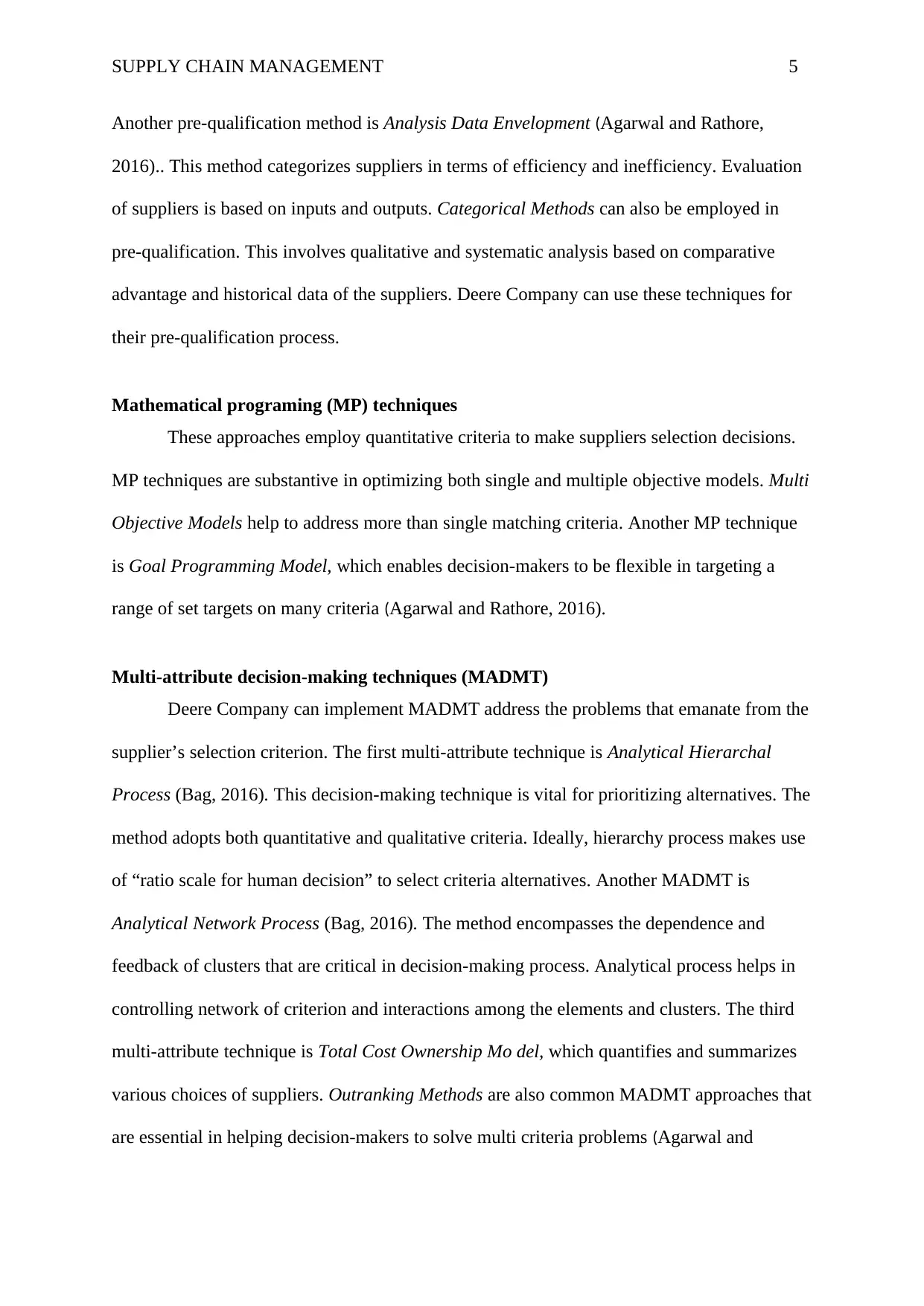
SUPPLY CHAIN MANAGEMENT 5
Another pre-qualification method is Analysis Data Envelopment (Agarwal and Rathore,
2016).. This method categorizes suppliers in terms of efficiency and inefficiency. Evaluation
of suppliers is based on inputs and outputs. Categorical Methods can also be employed in
pre-qualification. This involves qualitative and systematic analysis based on comparative
advantage and historical data of the suppliers. Deere Company can use these techniques for
their pre-qualification process.
Mathematical programing (MP) techniques
These approaches employ quantitative criteria to make suppliers selection decisions.
MP techniques are substantive in optimizing both single and multiple objective models. Multi
Objective Models help to address more than single matching criteria. Another MP technique
is Goal Programming Model, which enables decision-makers to be flexible in targeting a
range of set targets on many criteria (Agarwal and Rathore, 2016).
Multi-attribute decision-making techniques (MADMT)
Deere Company can implement MADMT address the problems that emanate from the
supplier’s selection criterion. The first multi-attribute technique is Analytical Hierarchal
Process (Bag, 2016). This decision-making technique is vital for prioritizing alternatives. The
method adopts both quantitative and qualitative criteria. Ideally, hierarchy process makes use
of “ratio scale for human decision” to select criteria alternatives. Another MADMT is
Analytical Network Process (Bag, 2016). The method encompasses the dependence and
feedback of clusters that are critical in decision-making process. Analytical process helps in
controlling network of criterion and interactions among the elements and clusters. The third
multi-attribute technique is Total Cost Ownership Mo del, which quantifies and summarizes
various choices of suppliers. Outranking Methods are also common MADMT approaches that
are essential in helping decision-makers to solve multi criteria problems (Agarwal and
Another pre-qualification method is Analysis Data Envelopment (Agarwal and Rathore,
2016).. This method categorizes suppliers in terms of efficiency and inefficiency. Evaluation
of suppliers is based on inputs and outputs. Categorical Methods can also be employed in
pre-qualification. This involves qualitative and systematic analysis based on comparative
advantage and historical data of the suppliers. Deere Company can use these techniques for
their pre-qualification process.
Mathematical programing (MP) techniques
These approaches employ quantitative criteria to make suppliers selection decisions.
MP techniques are substantive in optimizing both single and multiple objective models. Multi
Objective Models help to address more than single matching criteria. Another MP technique
is Goal Programming Model, which enables decision-makers to be flexible in targeting a
range of set targets on many criteria (Agarwal and Rathore, 2016).
Multi-attribute decision-making techniques (MADMT)
Deere Company can implement MADMT address the problems that emanate from the
supplier’s selection criterion. The first multi-attribute technique is Analytical Hierarchal
Process (Bag, 2016). This decision-making technique is vital for prioritizing alternatives. The
method adopts both quantitative and qualitative criteria. Ideally, hierarchy process makes use
of “ratio scale for human decision” to select criteria alternatives. Another MADMT is
Analytical Network Process (Bag, 2016). The method encompasses the dependence and
feedback of clusters that are critical in decision-making process. Analytical process helps in
controlling network of criterion and interactions among the elements and clusters. The third
multi-attribute technique is Total Cost Ownership Mo del, which quantifies and summarizes
various choices of suppliers. Outranking Methods are also common MADMT approaches that
are essential in helping decision-makers to solve multi criteria problems (Agarwal and
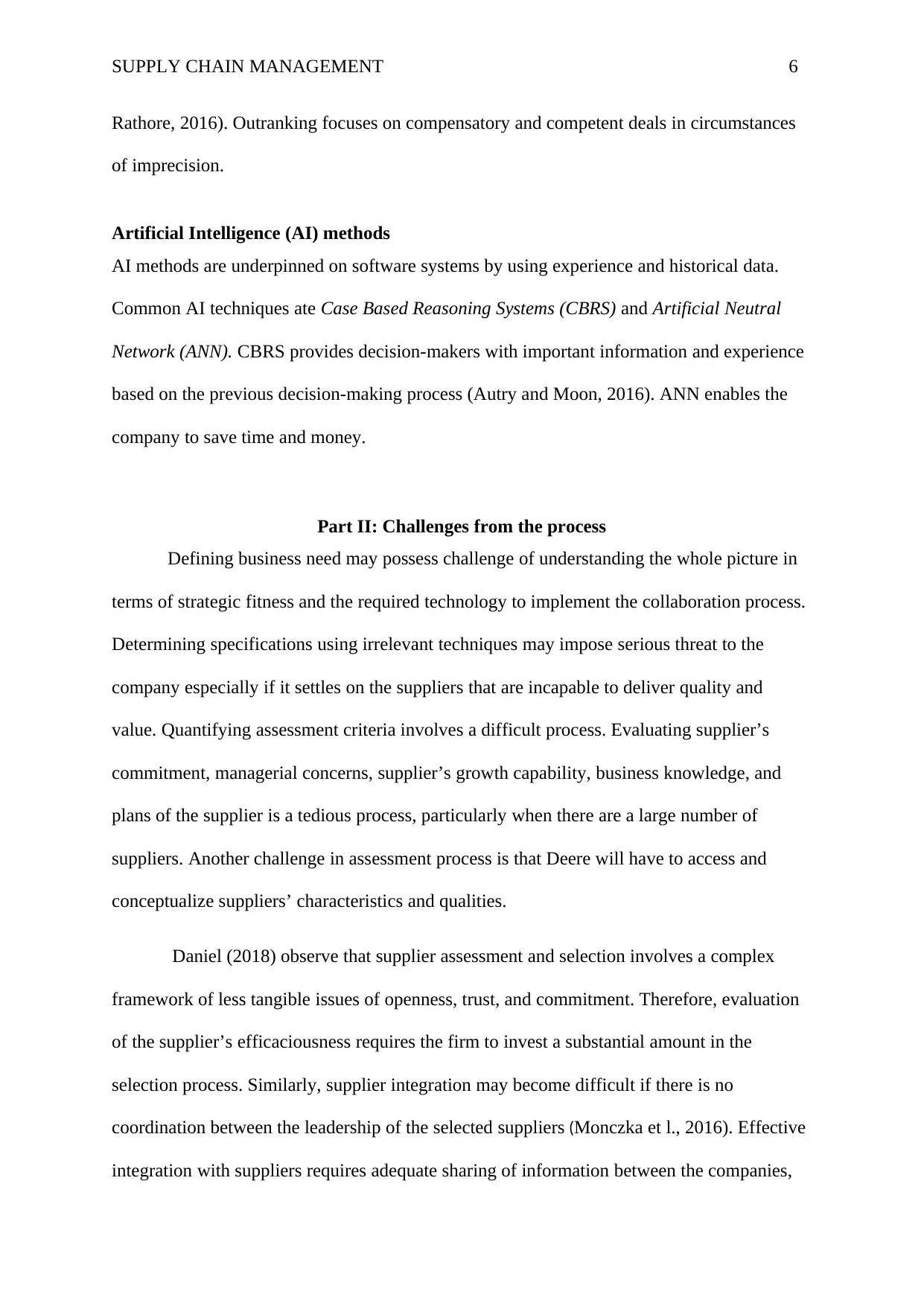
SUPPLY CHAIN MANAGEMENT 6
Rathore, 2016). Outranking focuses on compensatory and competent deals in circumstances
of imprecision.
Artificial Intelligence (AI) methods
AI methods are underpinned on software systems by using experience and historical data.
Common AI techniques ate Case Based Reasoning Systems (CBRS) and Artificial Neutral
Network (ANN). CBRS provides decision-makers with important information and experience
based on the previous decision-making process (Autry and Moon, 2016). ANN enables the
company to save time and money.
Part II: Challenges from the process
Defining business need may possess challenge of understanding the whole picture in
terms of strategic fitness and the required technology to implement the collaboration process.
Determining specifications using irrelevant techniques may impose serious threat to the
company especially if it settles on the suppliers that are incapable to deliver quality and
value. Quantifying assessment criteria involves a difficult process. Evaluating supplier’s
commitment, managerial concerns, supplier’s growth capability, business knowledge, and
plans of the supplier is a tedious process, particularly when there are a large number of
suppliers. Another challenge in assessment process is that Deere will have to access and
conceptualize suppliers’ characteristics and qualities.
Daniel (2018) observe that supplier assessment and selection involves a complex
framework of less tangible issues of openness, trust, and commitment. Therefore, evaluation
of the supplier’s efficaciousness requires the firm to invest a substantial amount in the
selection process. Similarly, supplier integration may become difficult if there is no
coordination between the leadership of the selected suppliers (Monczka et l., 2016). Effective
integration with suppliers requires adequate sharing of information between the companies,
Rathore, 2016). Outranking focuses on compensatory and competent deals in circumstances
of imprecision.
Artificial Intelligence (AI) methods
AI methods are underpinned on software systems by using experience and historical data.
Common AI techniques ate Case Based Reasoning Systems (CBRS) and Artificial Neutral
Network (ANN). CBRS provides decision-makers with important information and experience
based on the previous decision-making process (Autry and Moon, 2016). ANN enables the
company to save time and money.
Part II: Challenges from the process
Defining business need may possess challenge of understanding the whole picture in
terms of strategic fitness and the required technology to implement the collaboration process.
Determining specifications using irrelevant techniques may impose serious threat to the
company especially if it settles on the suppliers that are incapable to deliver quality and
value. Quantifying assessment criteria involves a difficult process. Evaluating supplier’s
commitment, managerial concerns, supplier’s growth capability, business knowledge, and
plans of the supplier is a tedious process, particularly when there are a large number of
suppliers. Another challenge in assessment process is that Deere will have to access and
conceptualize suppliers’ characteristics and qualities.
Daniel (2018) observe that supplier assessment and selection involves a complex
framework of less tangible issues of openness, trust, and commitment. Therefore, evaluation
of the supplier’s efficaciousness requires the firm to invest a substantial amount in the
selection process. Similarly, supplier integration may become difficult if there is no
coordination between the leadership of the selected suppliers (Monczka et l., 2016). Effective
integration with suppliers requires adequate sharing of information between the companies,
⊘ This is a preview!⊘
Do you want full access?
Subscribe today to unlock all pages.

Trusted by 1+ million students worldwide
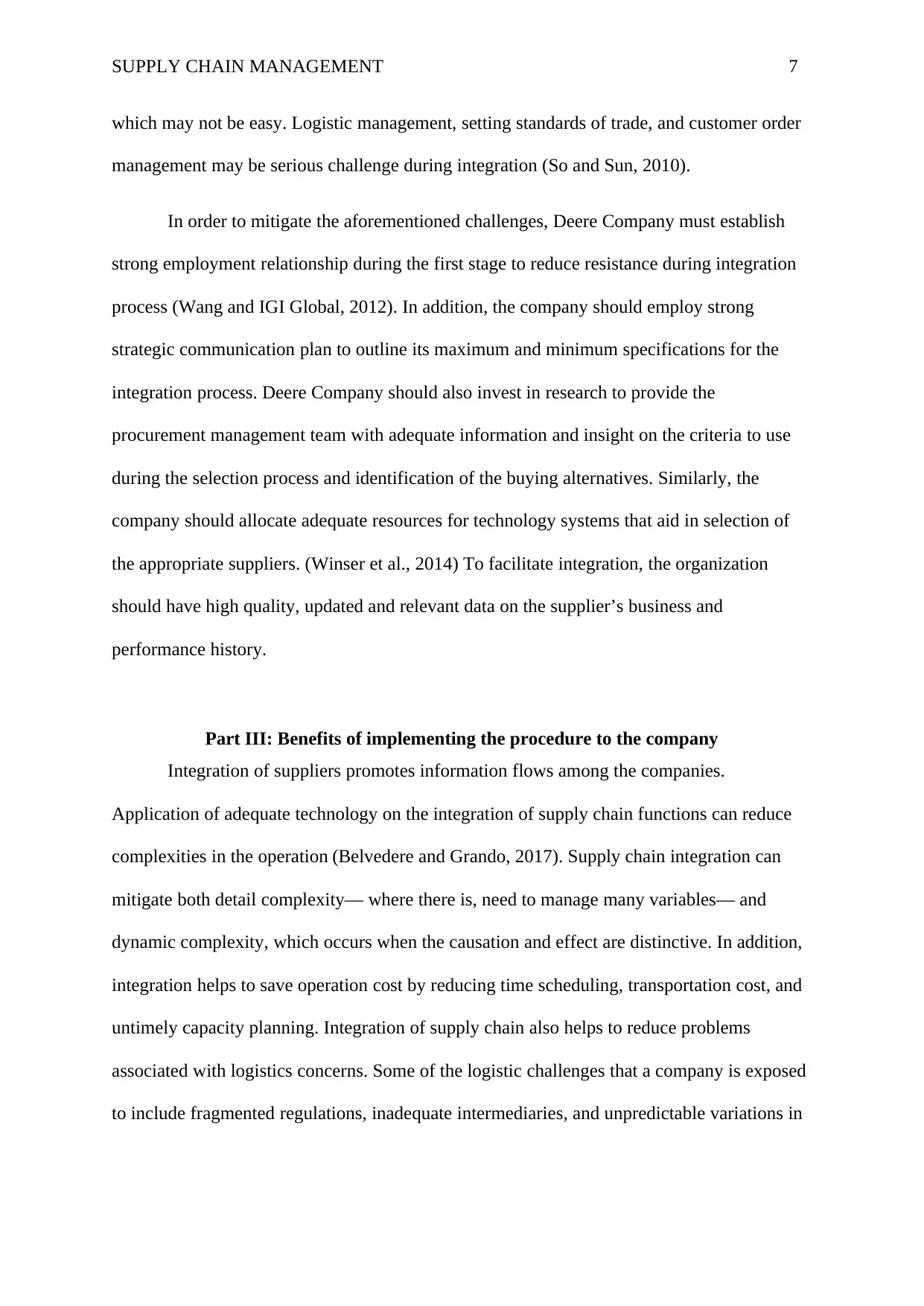
SUPPLY CHAIN MANAGEMENT 7
which may not be easy. Logistic management, setting standards of trade, and customer order
management may be serious challenge during integration (So and Sun, 2010).
In order to mitigate the aforementioned challenges, Deere Company must establish
strong employment relationship during the first stage to reduce resistance during integration
process (Wang and IGI Global, 2012). In addition, the company should employ strong
strategic communication plan to outline its maximum and minimum specifications for the
integration process. Deere Company should also invest in research to provide the
procurement management team with adequate information and insight on the criteria to use
during the selection process and identification of the buying alternatives. Similarly, the
company should allocate adequate resources for technology systems that aid in selection of
the appropriate suppliers. (Winser et al., 2014) To facilitate integration, the organization
should have high quality, updated and relevant data on the supplier’s business and
performance history.
Part III: Benefits of implementing the procedure to the company
Integration of suppliers promotes information flows among the companies.
Application of adequate technology on the integration of supply chain functions can reduce
complexities in the operation (Belvedere and Grando, 2017). Supply chain integration can
mitigate both detail complexity— where there is, need to manage many variables— and
dynamic complexity, which occurs when the causation and effect are distinctive. In addition,
integration helps to save operation cost by reducing time scheduling, transportation cost, and
untimely capacity planning. Integration of supply chain also helps to reduce problems
associated with logistics concerns. Some of the logistic challenges that a company is exposed
to include fragmented regulations, inadequate intermediaries, and unpredictable variations in
which may not be easy. Logistic management, setting standards of trade, and customer order
management may be serious challenge during integration (So and Sun, 2010).
In order to mitigate the aforementioned challenges, Deere Company must establish
strong employment relationship during the first stage to reduce resistance during integration
process (Wang and IGI Global, 2012). In addition, the company should employ strong
strategic communication plan to outline its maximum and minimum specifications for the
integration process. Deere Company should also invest in research to provide the
procurement management team with adequate information and insight on the criteria to use
during the selection process and identification of the buying alternatives. Similarly, the
company should allocate adequate resources for technology systems that aid in selection of
the appropriate suppliers. (Winser et al., 2014) To facilitate integration, the organization
should have high quality, updated and relevant data on the supplier’s business and
performance history.
Part III: Benefits of implementing the procedure to the company
Integration of suppliers promotes information flows among the companies.
Application of adequate technology on the integration of supply chain functions can reduce
complexities in the operation (Belvedere and Grando, 2017). Supply chain integration can
mitigate both detail complexity— where there is, need to manage many variables— and
dynamic complexity, which occurs when the causation and effect are distinctive. In addition,
integration helps to save operation cost by reducing time scheduling, transportation cost, and
untimely capacity planning. Integration of supply chain also helps to reduce problems
associated with logistics concerns. Some of the logistic challenges that a company is exposed
to include fragmented regulations, inadequate intermediaries, and unpredictable variations in
Paraphrase This Document
Need a fresh take? Get an instant paraphrase of this document with our AI Paraphraser
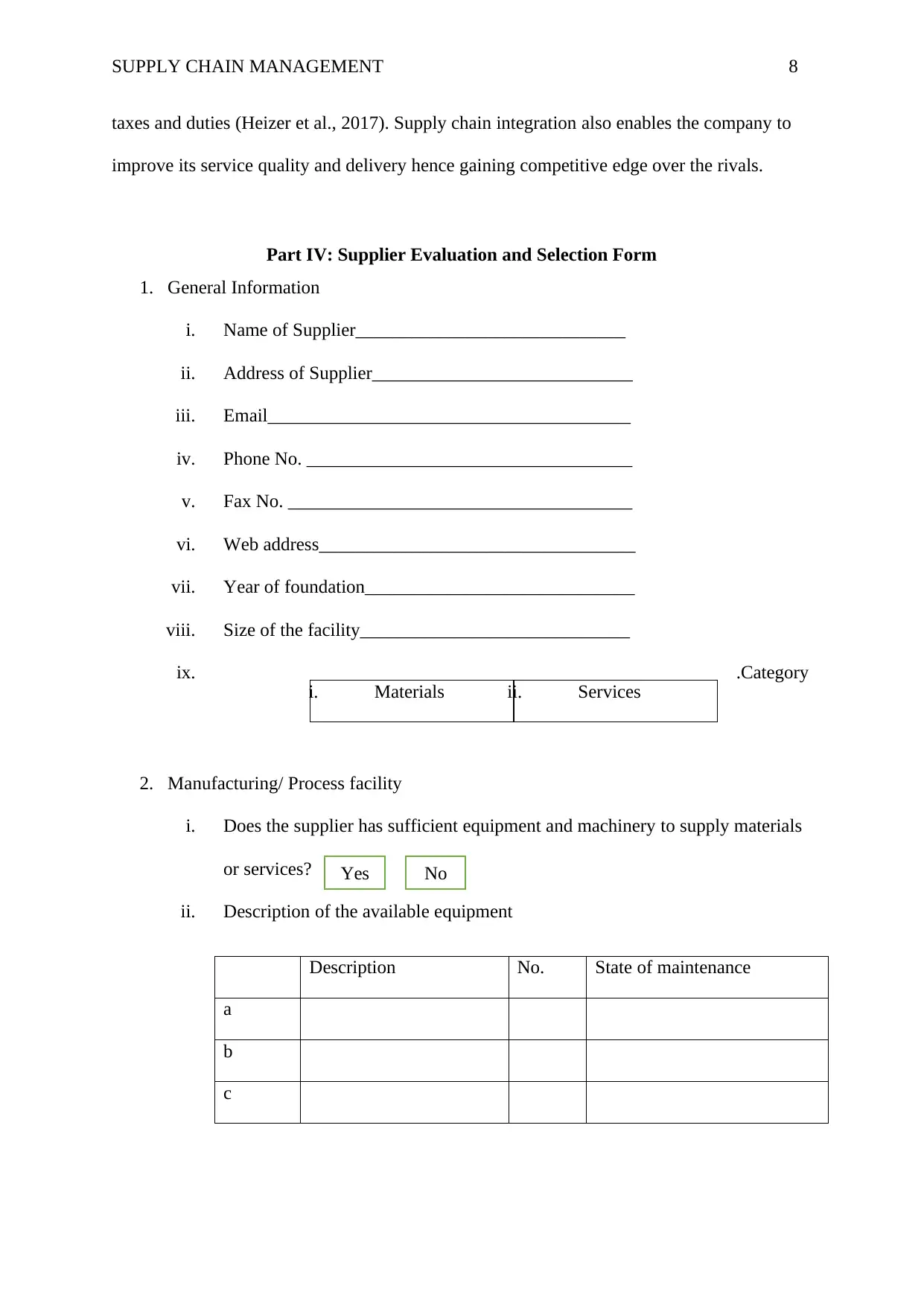
SUPPLY CHAIN MANAGEMENT 8
taxes and duties (Heizer et al., 2017). Supply chain integration also enables the company to
improve its service quality and delivery hence gaining competitive edge over the rivals.
Part IV: Supplier Evaluation and Selection Form
1. General Information
i. Name of Supplier_____________________________
ii. Address of Supplier____________________________
iii. Email_______________________________________
iv. Phone No. ___________________________________
v. Fax No. _____________________________________
vi. Web address__________________________________
vii. Year of foundation_____________________________
viii. Size of the facility_____________________________
ix. .Category
2. Manufacturing/ Process facility
i. Does the supplier has sufficient equipment and machinery to supply materials
or services?
ii. Description of the available equipment
Description No. State of maintenance
a
b
c
Yes No
i. Materials ii. Services
taxes and duties (Heizer et al., 2017). Supply chain integration also enables the company to
improve its service quality and delivery hence gaining competitive edge over the rivals.
Part IV: Supplier Evaluation and Selection Form
1. General Information
i. Name of Supplier_____________________________
ii. Address of Supplier____________________________
iii. Email_______________________________________
iv. Phone No. ___________________________________
v. Fax No. _____________________________________
vi. Web address__________________________________
vii. Year of foundation_____________________________
viii. Size of the facility_____________________________
ix. .Category
2. Manufacturing/ Process facility
i. Does the supplier has sufficient equipment and machinery to supply materials
or services?
ii. Description of the available equipment
Description No. State of maintenance
a
b
c
Yes No
i. Materials ii. Services
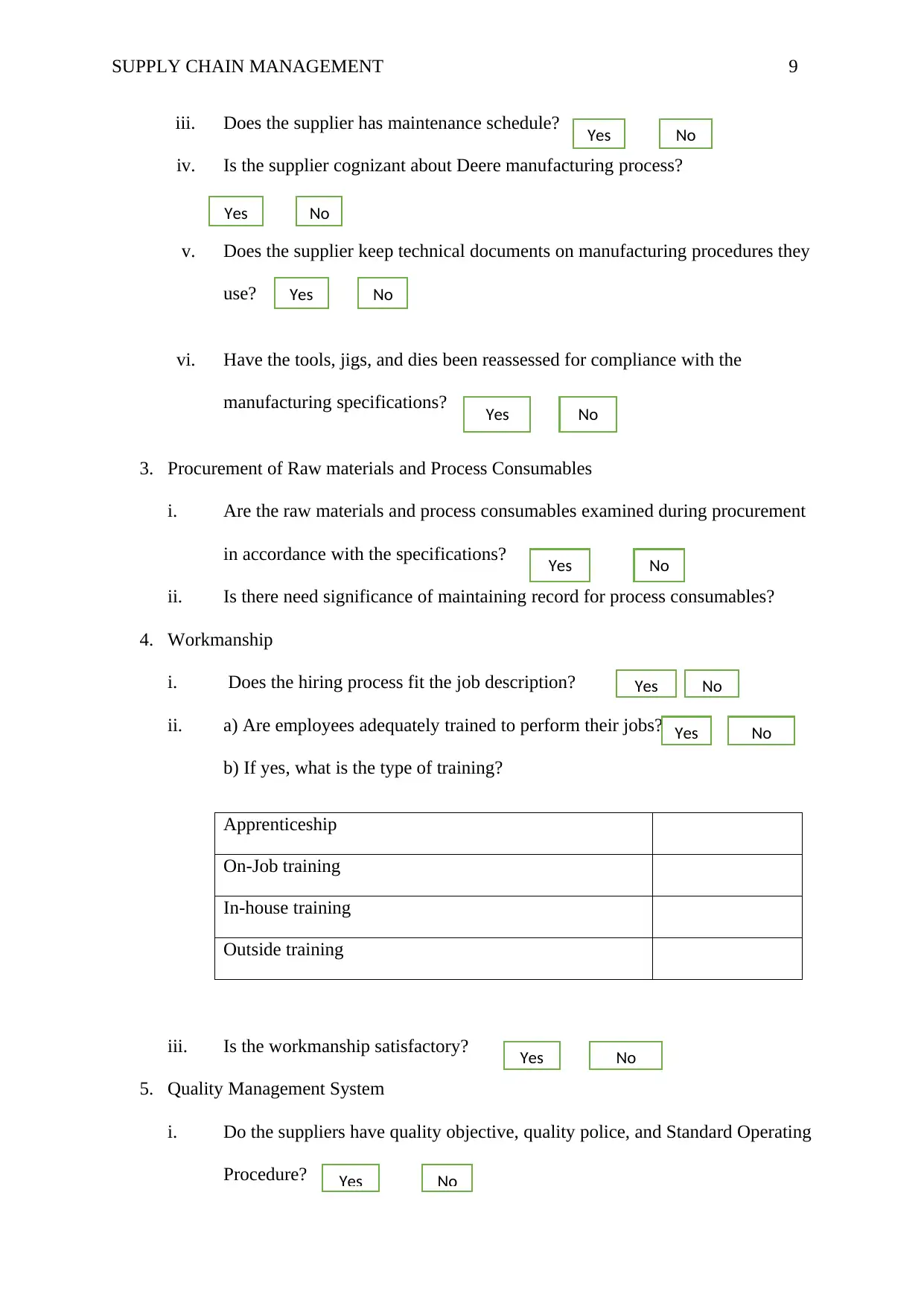
SUPPLY CHAIN MANAGEMENT 9
iii. Does the supplier has maintenance schedule?
iv. Is the supplier cognizant about Deere manufacturing process?
v. Does the supplier keep technical documents on manufacturing procedures they
use?
vi. Have the tools, jigs, and dies been reassessed for compliance with the
manufacturing specifications?
3. Procurement of Raw materials and Process Consumables
i. Are the raw materials and process consumables examined during procurement
in accordance with the specifications?
ii. Is there need significance of maintaining record for process consumables?
4. Workmanship
i. Does the hiring process fit the job description?
ii. a) Are employees adequately trained to perform their jobs?
b) If yes, what is the type of training?
Apprenticeship
On-Job training
In-house training
Outside training
iii. Is the workmanship satisfactory?
5. Quality Management System
i. Do the suppliers have quality objective, quality police, and Standard Operating
Procedure?
Yes No
Yes No
Yes No
Yes No
Yes No
Yes No
Yes No
Yes No
Yes No
iii. Does the supplier has maintenance schedule?
iv. Is the supplier cognizant about Deere manufacturing process?
v. Does the supplier keep technical documents on manufacturing procedures they
use?
vi. Have the tools, jigs, and dies been reassessed for compliance with the
manufacturing specifications?
3. Procurement of Raw materials and Process Consumables
i. Are the raw materials and process consumables examined during procurement
in accordance with the specifications?
ii. Is there need significance of maintaining record for process consumables?
4. Workmanship
i. Does the hiring process fit the job description?
ii. a) Are employees adequately trained to perform their jobs?
b) If yes, what is the type of training?
Apprenticeship
On-Job training
In-house training
Outside training
iii. Is the workmanship satisfactory?
5. Quality Management System
i. Do the suppliers have quality objective, quality police, and Standard Operating
Procedure?
Yes No
Yes No
Yes No
Yes No
Yes No
Yes No
Yes No
Yes No
Yes No
⊘ This is a preview!⊘
Do you want full access?
Subscribe today to unlock all pages.

Trusted by 1+ million students worldwide
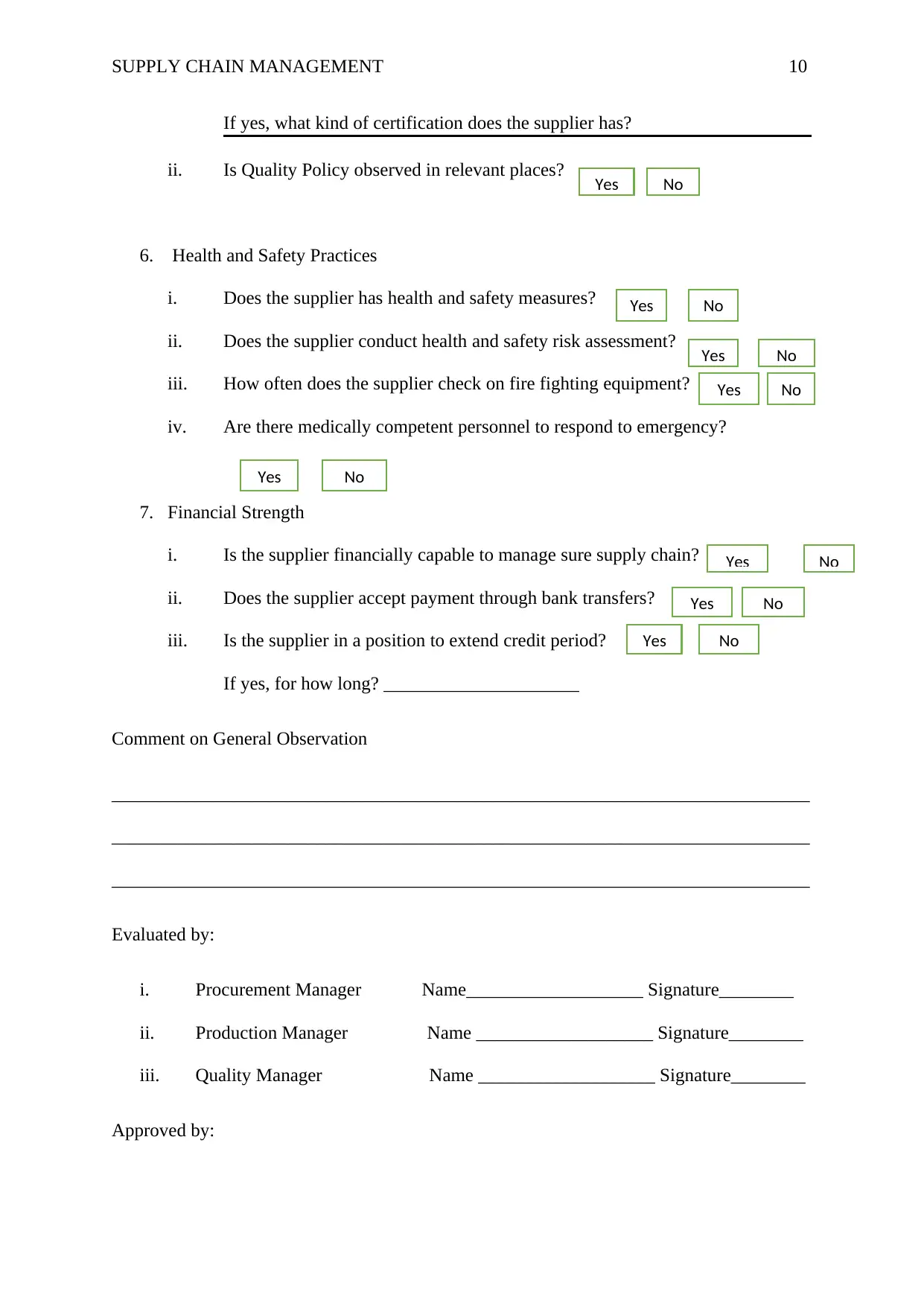
SUPPLY CHAIN MANAGEMENT 10
If yes, what kind of certification does the supplier has?
ii. Is Quality Policy observed in relevant places?
6. Health and Safety Practices
i. Does the supplier has health and safety measures?
ii. Does the supplier conduct health and safety risk assessment?
iii. How often does the supplier check on fire fighting equipment?
iv. Are there medically competent personnel to respond to emergency?
7. Financial Strength
i. Is the supplier financially capable to manage sure supply chain?
ii. Does the supplier accept payment through bank transfers?
iii. Is the supplier in a position to extend credit period?
If yes, for how long? _____________________
Comment on General Observation
___________________________________________________________________________
___________________________________________________________________________
___________________________________________________________________________
Evaluated by:
i. Procurement Manager Name___________________ Signature________
ii. Production Manager Name ___________________ Signature________
iii. Quality Manager Name ___________________ Signature________
Approved by:
Yes No
Yes No
Yes No
Yes No
Yes No
Yes No
Yes No
Yes No
If yes, what kind of certification does the supplier has?
ii. Is Quality Policy observed in relevant places?
6. Health and Safety Practices
i. Does the supplier has health and safety measures?
ii. Does the supplier conduct health and safety risk assessment?
iii. How often does the supplier check on fire fighting equipment?
iv. Are there medically competent personnel to respond to emergency?
7. Financial Strength
i. Is the supplier financially capable to manage sure supply chain?
ii. Does the supplier accept payment through bank transfers?
iii. Is the supplier in a position to extend credit period?
If yes, for how long? _____________________
Comment on General Observation
___________________________________________________________________________
___________________________________________________________________________
___________________________________________________________________________
Evaluated by:
i. Procurement Manager Name___________________ Signature________
ii. Production Manager Name ___________________ Signature________
iii. Quality Manager Name ___________________ Signature________
Approved by:
Yes No
Yes No
Yes No
Yes No
Yes No
Yes No
Yes No
Yes No
Paraphrase This Document
Need a fresh take? Get an instant paraphrase of this document with our AI Paraphraser
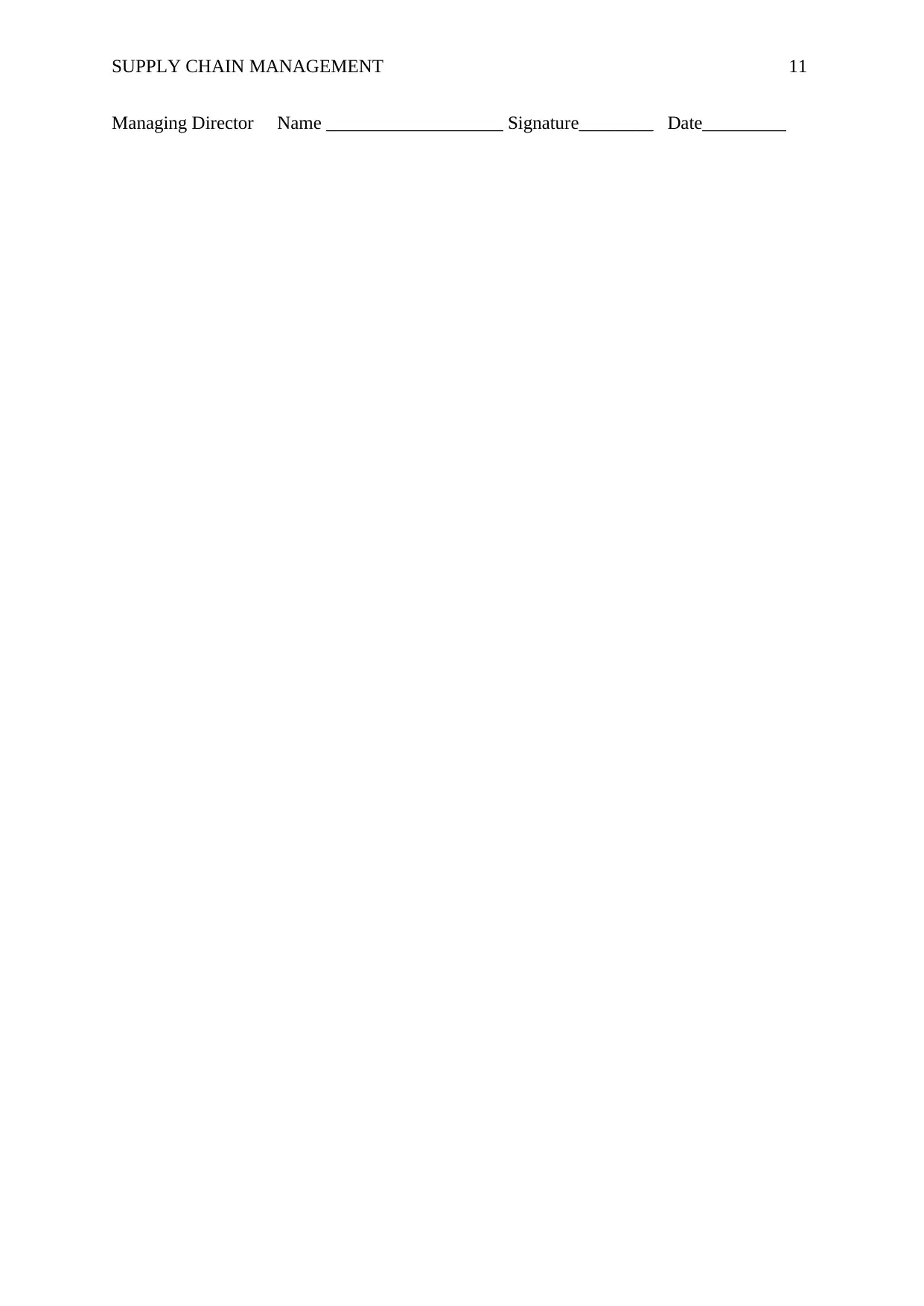
SUPPLY CHAIN MANAGEMENT 11
Managing Director Name ___________________ Signature________ Date_________
Managing Director Name ___________________ Signature________ Date_________
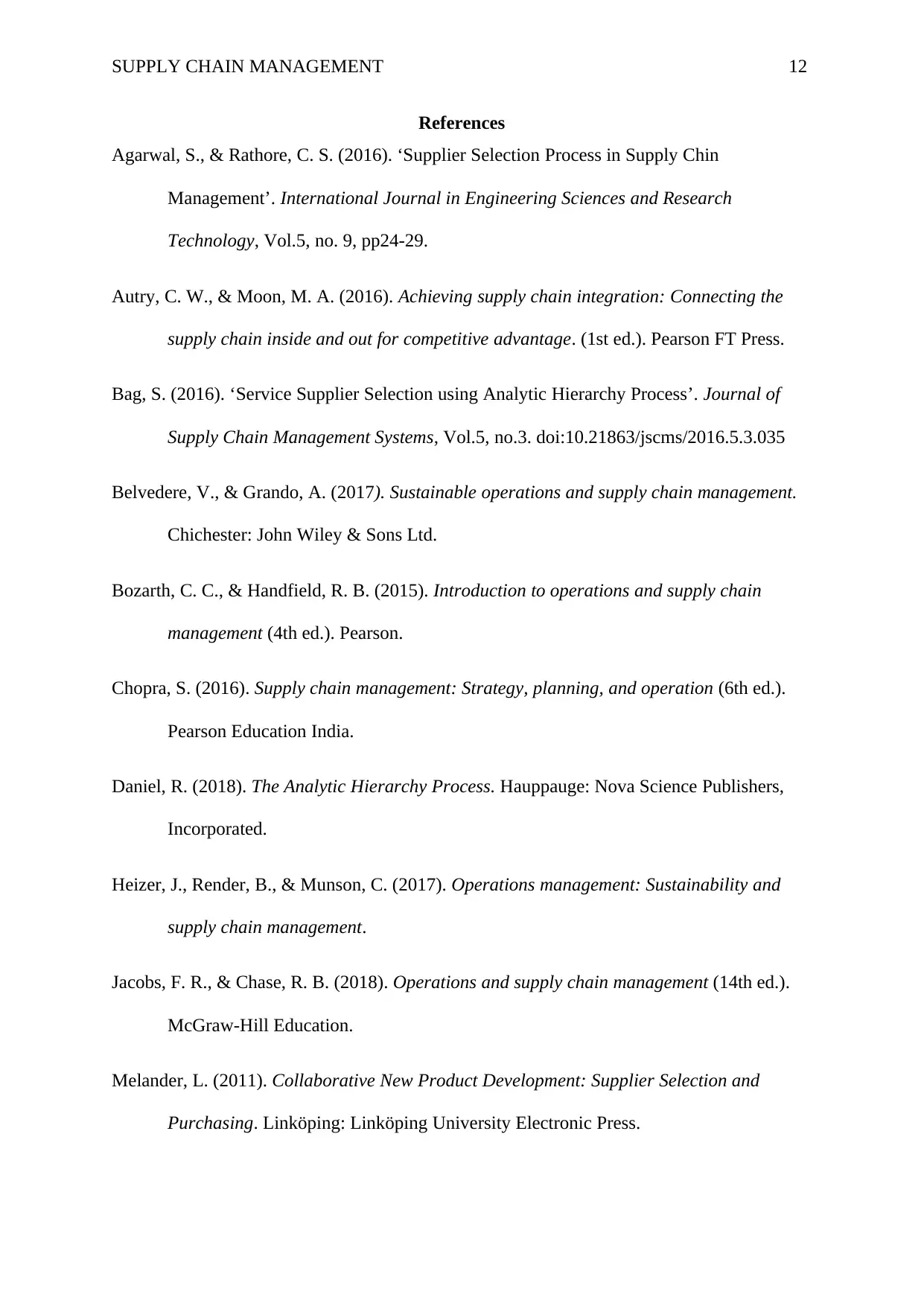
SUPPLY CHAIN MANAGEMENT 12
References
Agarwal, S., & Rathore, C. S. (2016). ‘Supplier Selection Process in Supply Chin
Management’. International Journal in Engineering Sciences and Research
Technology, Vol.5, no. 9, pp24-29.
Autry, C. W., & Moon, M. A. (2016). Achieving supply chain integration: Connecting the
supply chain inside and out for competitive advantage. (1st ed.). Pearson FT Press.
Bag, S. (2016). ‘Service Supplier Selection using Analytic Hierarchy Process’. Journal of
Supply Chain Management Systems, Vol.5, no.3. doi:10.21863/jscms/2016.5.3.035
Belvedere, V., & Grando, A. (2017). Sustainable operations and supply chain management.
Chichester: John Wiley & Sons Ltd.
Bozarth, C. C., & Handfield, R. B. (2015). Introduction to operations and supply chain
management (4th ed.). Pearson.
Chopra, S. (2016). Supply chain management: Strategy, planning, and operation (6th ed.).
Pearson Education India.
Daniel, R. (2018). The Analytic Hierarchy Process. Hauppauge: Nova Science Publishers,
Incorporated.
Heizer, J., Render, B., & Munson, C. (2017). Operations management: Sustainability and
supply chain management.
Jacobs, F. R., & Chase, R. B. (2018). Operations and supply chain management (14th ed.).
McGraw-Hill Education.
Melander, L. (2011). Collaborative New Product Development: Supplier Selection and
Purchasing. Linköping: Linköping University Electronic Press.
References
Agarwal, S., & Rathore, C. S. (2016). ‘Supplier Selection Process in Supply Chin
Management’. International Journal in Engineering Sciences and Research
Technology, Vol.5, no. 9, pp24-29.
Autry, C. W., & Moon, M. A. (2016). Achieving supply chain integration: Connecting the
supply chain inside and out for competitive advantage. (1st ed.). Pearson FT Press.
Bag, S. (2016). ‘Service Supplier Selection using Analytic Hierarchy Process’. Journal of
Supply Chain Management Systems, Vol.5, no.3. doi:10.21863/jscms/2016.5.3.035
Belvedere, V., & Grando, A. (2017). Sustainable operations and supply chain management.
Chichester: John Wiley & Sons Ltd.
Bozarth, C. C., & Handfield, R. B. (2015). Introduction to operations and supply chain
management (4th ed.). Pearson.
Chopra, S. (2016). Supply chain management: Strategy, planning, and operation (6th ed.).
Pearson Education India.
Daniel, R. (2018). The Analytic Hierarchy Process. Hauppauge: Nova Science Publishers,
Incorporated.
Heizer, J., Render, B., & Munson, C. (2017). Operations management: Sustainability and
supply chain management.
Jacobs, F. R., & Chase, R. B. (2018). Operations and supply chain management (14th ed.).
McGraw-Hill Education.
Melander, L. (2011). Collaborative New Product Development: Supplier Selection and
Purchasing. Linköping: Linköping University Electronic Press.
⊘ This is a preview!⊘
Do you want full access?
Subscribe today to unlock all pages.

Trusted by 1+ million students worldwide
1 out of 13
Related Documents
Your All-in-One AI-Powered Toolkit for Academic Success.
+13062052269
info@desklib.com
Available 24*7 on WhatsApp / Email
![[object Object]](/_next/static/media/star-bottom.7253800d.svg)
Unlock your academic potential
Copyright © 2020–2025 A2Z Services. All Rights Reserved. Developed and managed by ZUCOL.





